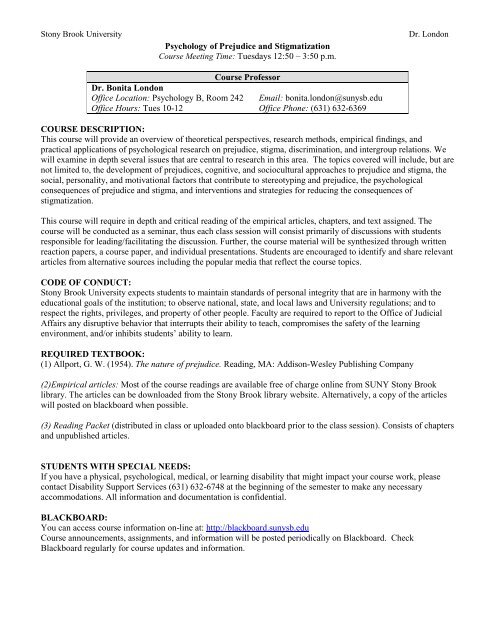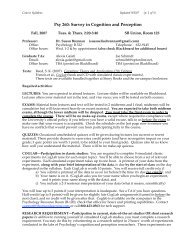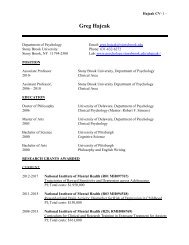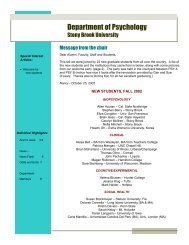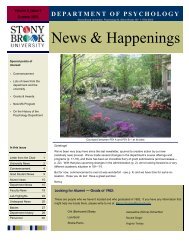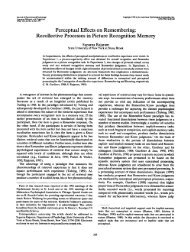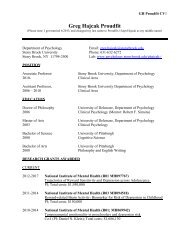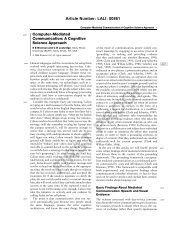PSY 240: Survey in Social Psychology - Psychology Department ...
PSY 240: Survey in Social Psychology - Psychology Department ...
PSY 240: Survey in Social Psychology - Psychology Department ...
You also want an ePaper? Increase the reach of your titles
YUMPU automatically turns print PDFs into web optimized ePapers that Google loves.
Stony Brook UniversityDr. LondonYou must submit a 1 page description of your proposed f<strong>in</strong>al paper November 6 th , 2007. Follow<strong>in</strong>gyour proposal submission, you should schedule a meet<strong>in</strong>g with the Instructor to discuss your f<strong>in</strong>alpaper.Paper Format: Your paper must be typed and written <strong>in</strong> accordance with the guidel<strong>in</strong>es of theAmerican Psychological Association’s Publication Manual. Your paper should be approximately 9-15 double-spaced pages (not <strong>in</strong>clud<strong>in</strong>g references and cover page) us<strong>in</strong>g standard font and marg<strong>in</strong>s(1-<strong>in</strong>ch). F<strong>in</strong>al paper is due <strong>in</strong> class on December 11 th . Grade deductions will be taken for latepapers.(5) Individual presentation: (5% of grade)Dur<strong>in</strong>g the f<strong>in</strong>al two class sessions students will present their F<strong>in</strong>al paper topic to the class <strong>in</strong> a formalpresentation. Presentation dates will be scheduled for December 4 th and 11 th .(6) Portfolio: (5% of grade)You will create a Portfolio that consists of all of your written materials submitted for this course, i.e.,your weekly response papers, discussion questions, f<strong>in</strong>al paper and any notes from your <strong>in</strong>dividualpresentation (e.g., powerpo<strong>in</strong>t slides). The goal of the Portfolio is simply to encourage you to keep acomplete file of all of your work <strong>in</strong> this course for future reference. As you progress through graduateschool, your portfolio for this class may serve as a convenient summary of the current and major works<strong>in</strong> this literature, and may be a useful resource <strong>in</strong> help<strong>in</strong>g you to generate new ideas and researchdirections <strong>in</strong> your field of study.You must make two bound (<strong>in</strong> a folder or formal spiral b<strong>in</strong>d<strong>in</strong>g) copies of your Portfolio – one tosubmit and one to keep for yourself. The contents of your Portfolio will not be re-graded. By mak<strong>in</strong>gtwo copies and submitt<strong>in</strong>g your portfolio on the due date, you will receive the full 5 pts.Portfolio’s are due <strong>in</strong> class on December 11 th .Your f<strong>in</strong>al letter grade will be based on the follow<strong>in</strong>g grad<strong>in</strong>g scale:Letter Grade = Score Letter Grade = ScoreA = 93-100 C = 73-76A- = 90-92 C- = 70-72B+ = 87-89 D+ = 67-69B = 83-86 D = 60-66B- = 80-82 F = < 60C+ = 77-79
Stony Brook UniversityDr. LondonSCHEDULE OF READINGSNOTE: All read<strong>in</strong>gs are due on the day they are listed <strong>in</strong> the schedule, with the exception of the first class.Read<strong>in</strong>gs marked with an ** will be provided by the Instructor. All other read<strong>in</strong>gs may be downloaded from theStony Brook library website.DATE TOPIC READINGSSept. 4Sept. 11Sept. 18Sept. 25Oct. 2Intro/Overview<strong>Social</strong> IdentitiesDevelopment ofPrejudiceCognitive approaches toStigma and Prejudice(cont’d)(1) ** Jordan, C. H., & Zanna, M.P. (2000). How to read a journal article <strong>in</strong>social psychology. In C. Stangor (Ed). Stereotypes and Prejudice:Essential Read<strong>in</strong>gs (pp. 457-466). Philadelphia, PA: <strong>Psychology</strong> Press,Taylor & Francis Grp.(2) Allport: Chapters 1 and 2Response & Discussion Questions Due (not graded/feedback only)(1) Ashmore, R. D., Deaux, K., & McLaughl<strong>in</strong>-Volpe, T. (2004). An organiz<strong>in</strong>gframework for collective identity: Articulation and significance ofmultidimensionality. Psychological Bullet<strong>in</strong>, 130, 80-114.(2) ** London, B., Downey, G., Bolger, N., & Velilla, E. (2005). Aframework for study<strong>in</strong>g social identity and cop<strong>in</strong>g with daily stressdur<strong>in</strong>g the transition to college. In G. Downey, J. Eccles, & C. Chatman,(Eds). Navigat<strong>in</strong>g the future: <strong>Social</strong> identity, cop<strong>in</strong>g, and life tasks. RSFPress: NY(3) Allport: Chapters 3 and 4Response & Discussion Questions # 1(1) ** Dovidio, J. F., Major, B., & Crocker, J. (2000). Stigma: Introduction andoverview. In T. F. Heatherton, R. E. Kleck, M. R. Hebl, & J. G. Hull (Eds.),The social psychology of stigma (pp. 1-17). New York: Guilford.(2) ** Stangor, C., & Crandall, C. (2000). Threat and the social construction ofstigma. In T. Heatherton, R. Kleck, M. Hebl, & J. Hull (Eds.), The socialpsychology of stigma. (pp. 62-87). New York: Guilford Press.(3) ** Goffman, E., (1963). Stigma: Notes on the management of spoiledidentity. Simon & Schuster, Inc: NY (pp. 1-19)(4) Allport: Chapters 18, 19, 20, and 21Response & Discussion Questions # 2Try the Implicit Associations Test:https://implicit.harvard.edu/implicit/demo/selectatest.html(1) Fazio, R. H., Jackson, J.R., Dunton, B.C., & Williams, C. J. (1995).Variability <strong>in</strong> automatic activation as an unobtrusive measure of racialattitudes: A bona fide pipel<strong>in</strong>e? Journal of Personality and <strong>Social</strong><strong>Psychology</strong>, 69, 1013-1027.(2) Greenwald, A.G., McGhee, D.E., & Schwartz, J.L.K. (1998). Measur<strong>in</strong>g<strong>in</strong>dividual differences <strong>in</strong> implicit cognition: The implicit associations test.Journal of Personality and <strong>Social</strong> <strong>Psychology</strong>, 74, 1464-1480.(3) Macrae, C.N., Milne, A.B., & Bodenhausen, G.V. (1994). Stereotypes asenergy-sav<strong>in</strong>g devices: A peek <strong>in</strong>side the cognitive toolbox. Journal ofPersonality and <strong>Social</strong> <strong>Psychology</strong>, 66, 37-47.(4) Allport: Chapter 10Response & Discussion Questions # 3(1) Bargh, J.A., Chen, M., & Burrows, L. (1996). Automaticity of socialbehavior: Direct effects of trait construct and stereotype activation on action.Journal of Personality and <strong>Social</strong> <strong>Psychology</strong>, 55, 726-737.(2) Dev<strong>in</strong>e, P.G. (1989). Stereotypes and prejudice: Their automatic andcontrolled components. Journal of Personality and <strong>Social</strong> <strong>Psychology</strong>, 56,5-18.(3) Kunda, Z., & Oleson, K.C. (1995). Ma<strong>in</strong>ta<strong>in</strong><strong>in</strong>g stereotypes <strong>in</strong> the face ofdisconfirmation: Construct<strong>in</strong>g grounds for subtyp<strong>in</strong>g deviants. Journal ofPersonality and <strong>Social</strong> <strong>Psychology</strong>, 68, 565-579.


